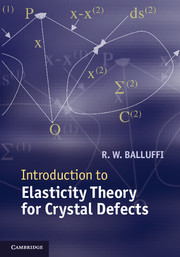Book contents
- Frontmatter
- Contents
- Preface
- Acknowledgements
- Frequently used symbols
- 1 Introduction
- 2 Basic elements of linear elasticity
- 3 Methods
- 4 Green's functions for unit point force
- 5 Interactions between defects and stress
- 6 Inclusions in infinite homogeneous regions
- 7 Interactions between inclusions and imposed stress
- 8 Inclusions in finite regions – image effects
- 9 Inhomogeneities
- 10 Point defects in infinite homogeneous regions
- 11 Point defects and stress – image effects in finite bodies
- 12 Dislocations in infinite homogeneous regions
- 13 Dislocations and stress – image effects in finite regions
- 14 Interfaces
- 15 Interactions between interfaces and stress
- 16 Interactions between defects
- Appendix A Relationships involving the ∇ operator
- Appendix B Integral relationships
- Appendix C The tensor product of two vectors
- Appendix D Properties of the delta function
- Appendix E The alternator operator
- Appendix F Fourier transforms
- Appendix G Equations from the theory of isotropic elasticity
- Appendix H Components of the Eshelby tensor in isotropic system
- Appendix I Airy stress functions for plane strain
- Appendix J Deviatoric stress and strain in isotropic system
- References
- Index
16 - Interactions between defects
- Frontmatter
- Contents
- Preface
- Acknowledgements
- Frequently used symbols
- 1 Introduction
- 2 Basic elements of linear elasticity
- 3 Methods
- 4 Green's functions for unit point force
- 5 Interactions between defects and stress
- 6 Inclusions in infinite homogeneous regions
- 7 Interactions between inclusions and imposed stress
- 8 Inclusions in finite regions – image effects
- 9 Inhomogeneities
- 10 Point defects in infinite homogeneous regions
- 11 Point defects and stress – image effects in finite bodies
- 12 Dislocations in infinite homogeneous regions
- 13 Dislocations and stress – image effects in finite regions
- 14 Interfaces
- 15 Interactions between interfaces and stress
- 16 Interactions between defects
- Appendix A Relationships involving the ∇ operator
- Appendix B Integral relationships
- Appendix C The tensor product of two vectors
- Appendix D Properties of the delta function
- Appendix E The alternator operator
- Appendix F Fourier transforms
- Appendix G Equations from the theory of isotropic elasticity
- Appendix H Components of the Eshelby tensor in isotropic system
- Appendix I Airy stress functions for plane strain
- Appendix J Deviatoric stress and strain in isotropic system
- References
- Index
Summary
Introduction
The fundamentals necessary to analyze the interaction energies and forces thatcan occur between the various defects treated in this book are now in place. Theelastic fields produced by the defects, and the interactions between the defectsand various elastic fields, have been formulated in previous chapters.
The general procedure for determining the interaction between two defects is toobtain the elastic field due to one defect at the location of the other and thento determine the interaction of the latter defect with this field. Since thenumber of possible defect–defect interactions is far too large toconsider comprehensively, this final chapter is restricted to a limited numberof representative interactions, which serve to demonstrate basic methods.
Point defect–point defect interactions
First, a general formulation is given of the interaction energy between two pointdefects that are represented by force multipoles, as in Chapters 10 and 11.Following this, the interaction between two point defects, each possessing cubicdefect symmetry, is analyzed for the case of an isotropic system.
General formulation
The interaction energy between a single point defect and a general elastic fieldhas been formulated in Chapter 11 (see Eqs. (11.1)–(11.4)), and the displacementfield due to a force multipole is given by Eq. (10.10). The interaction energybetween two point defects, i.e., D1 and D2, can therefore be obtained byimagining that D2 is created at the origin in the presence of D1 at theposition, x, and using the above results for the interaction energy and requiredelastic field.
Information
- Type
- Chapter
- Information
- Introduction to Elasticity Theory for Crystal Defects , pp. 386 - 410Publisher: Cambridge University PressPrint publication year: 2012
